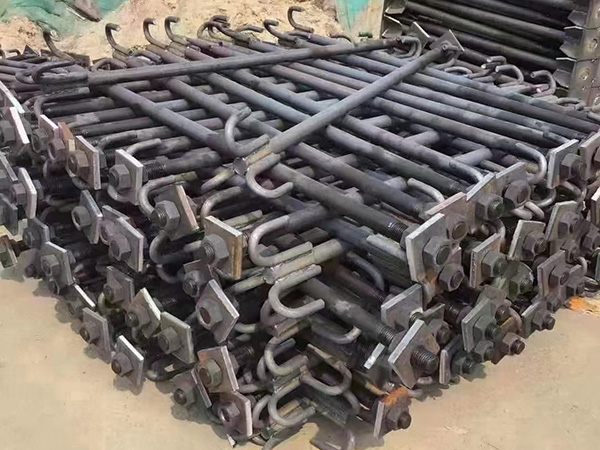-
Working Hours: (00:00 - 24:00)
24/7 Service -
Email:
1029975446@qq.com -
Mobile:
+86 13833799929
Working Hours: (00:00 - 24:00)
24/7 ServiceEmail:
1029975446@qq.comMobile:
+86 13833799929
1、 Basic concepts
Anchor claw type anchor bolt is a special type of bolt used to fix equipment, structural components, etc. in concrete foundations, named after its end with an anchoring structure similar to a "claw". Its core function is to provide strong anti pull and anti shear bearing capacity through the mechanical interlocking between the anchor claw and the concrete, and to confirm the stability of the equipment under vibration, load and other working conditions.
Structural Features
Overall structure
Screw: usually made of round steel or threaded steel, with threads machined on the upper end, used to connect nuts and washers to equipment bases.
Anchor Claw (Anchor End):
Shape: commonly known as "L-shaped", "U-shaped" or "claw like fork" (similar to chicken feet), fixed with screws through welding or hot forging processes.
Function: Increase the contact area with concrete, use the gripping force of concrete to achieve anchoring, and prevent bolts from being pulled out.
Welding plate (optional): Some anchor claw type bolts will weld steel plates near the anchor claws to further enhance their pull-out performance (similar to the design of "welding plate anchor bolts").
material
Screw: Q235, Q345 carbon structural steel, or 304, 316 stainless steel (used in corrosive environments).
Anchor Claw: Consistent with the material of the screw, welding requires protection of strength (such as using E43 and E50 welding rods).
3、 Classification and Application Scenarios
Classification method
According to the shape of the anchor claws:
L-shaped anchor claw: The end is a single right angled bend, with a simple structure, suitable for small and medium-sized equipment.
U-shaped anchor claw: with a U-shaped ring at the end, it has better pull-out resistance than L-shaped and is commonly used in scenarios where it can withstand large loads.
Forked anchor claw: The end is divided into multiple claw like branches (such as Y-shaped, multi claw type), with exquisite anchoring technology, suitable for heavy machinery or vibrating equipment.
According to whether the plate is welded or not: pure anchor claw type (without welded plate), welded plate anchor claw type (combined with the characteristics of welded plate anchor bolts).
Typical applications
Power industry: fixed transformers, tower foundations, distribution cabinets, etc.
Mechanical manufacturing: Installation of large machine tools, compressors, fans, and other vibration equipment.
Building structure: Steel structure column base anchoring, bridge support fixation, industrial equipment foundation connection.
Municipal engineering: the foundation fixation of outdoor facilities such as street lamp poles, traffic signal poles, and billboards.
4、 Advantages and limitations
advantage
Strong anchoring force: The mechanical interlocking between the anchor claw and concrete can provide higher resistance to pulling and shear than ordinary anchor bolts (such as straight rod type).
Flexible installation: The anchor claw size and shape can be adjusted according to the equipment load requirements, with strong adaptability.
Anti loosening: The anchor claws are embedded in concrete to form an irreversible connection, preventing the bolts from loosening due to vibration.
limitation
High construction difficulty: Careful positioning is required before pouring concrete, and errors in the direction and scale of the anchor claws can affect the anchoring effect.
Non reusable: The bolts are difficult to disassemble or adjust after being embedded, and the installation position of the equipment needs to be confirmed in advance.
High requirements for concrete strength: C25 or higher grade concrete is required, otherwise anchorage failure may occur due to concrete fragmentation.
5、 Key points of construction
Positioning and fixation
Use a standardized template or positioning bracket to confirm that the verticality and spacing of the bolts meet the design requirements (usually with an error of ≤ 2mm).
The anchor claws should be fully embedded in the concrete foundation, with a distance of generally ≥ 100mm from the surface of the foundation, to avoid affecting the stress on the bolts.
Concreting
During pouring, avoid direct impact of the vibrating rod on the bolt to prevent displacement of the anchor claw or deformation of the screw.
After the initial setting of the concrete, the bolt position should be rechecked, and any deviation should be corrected in a timely manner (slight adjustments can be made to the partially solidified concrete).
Anti corrosion treatment (based on actual reports)
Exposed screws need to be coated with anti rust paint or galvanized. In humid environments, stainless steel materials or epoxy coatings can be used.